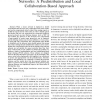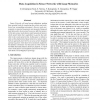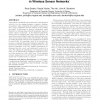ISPAN
2005
IEEE
14 years 3 months ago
2005
IEEE
Addition of new nodes to a Sensor Network is a fundamental requirement for their continuity operation over time. We analyze the weakening of security due to node capture when addi...
IPCCC
2005
IEEE
14 years 3 months ago
2005
IEEE
A wireless sensor network (WSN) typically consists of a large number of small sensor nodes and one or more highend control and data aggregation nodes. Sensor nodes have limited co...
INFOCOM
2005
IEEE
14 years 3 months ago
2005
IEEE
— When a sensor network is deployed in hostile environments, the adversary may compromise some sensor nodes, and use the compromised nodes to inject false sensing reports or modi...
INFOCOM
2005
IEEE
14 years 3 months ago
2005
IEEE
— We consider a network of rechargeable sensors, deployed redundantly in a random sensing environment, and address the problem of how sensor nodes should be activated dynamically...
ICPADS
2005
IEEE
14 years 3 months ago
2005
IEEE
Future large-scale sensor networks may comprise thousands of wirelessly connected sensor nodes that could provide an unimaginable opportunity to interact with physical phenomena i...
ICDE
2005
IEEE
14 years 3 months ago
2005
IEEE
Sensor Networks will soon become ubiquitous, making them essential tools for monitoring the activity and evolution of our surrounding environment. However such environments are ex...
SIGCSE
2006
ACM
14 years 3 months ago
2006
ACM
Target tracking is one of the most important applications of wireless sensor networks. Optimized computation and energy dissipation are critical requirements to maximize the lifet...
SIGCOMM
2006
ACM
14 years 3 months ago
2006
ACM
Sensor networks are especially useful in catastrophic or emergency scenarios such as floods, fires, terrorist attacks or earthquakes where human participation may be too dangero...
SENSYS
2006
ACM
14 years 3 months ago
2006
ACM
It is vital to support concurrent applications sharing a wireless sensor network in order to reduce the deployment and administrative costs, thus increasing the usability and ef�...
SENSYS
2006
ACM
14 years 3 months ago
2006
ACM
The problem of localization in wireless sensor networks where nodes do not use ranging hardware, remains a challenging problem, when considering the required location accuracy, en...



